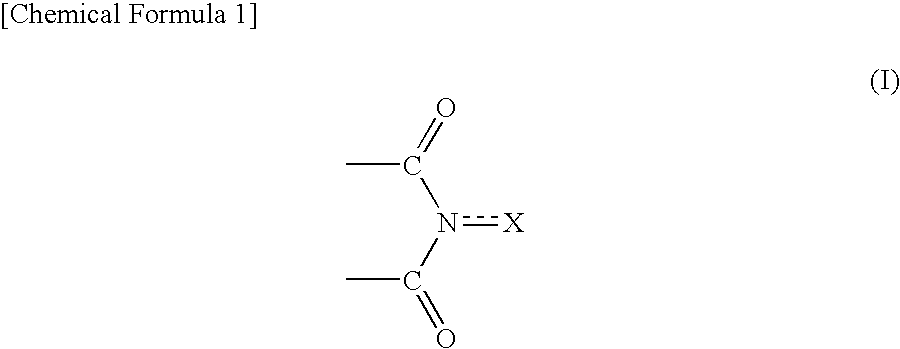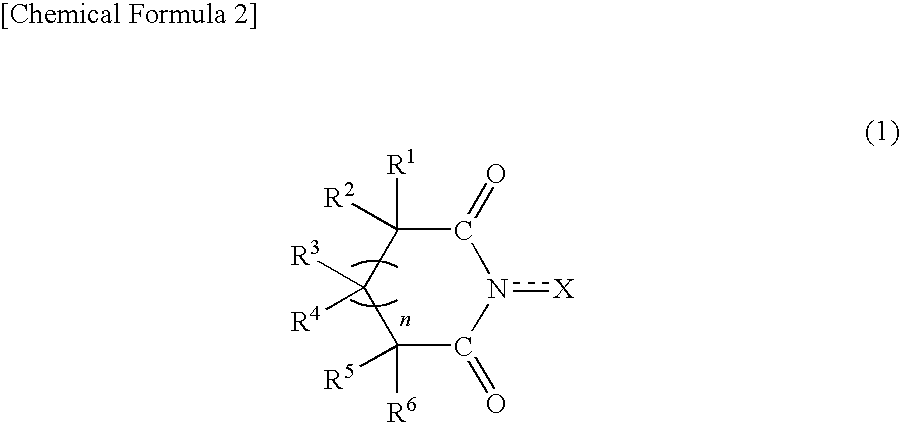Method for producing oxidation product of cycloalkane
a technology of cycloalkane and reaction product, which is applied in the field of producing oxidation reaction product of cycloalkane, can solve the problems of adversely affecting typically a subsequent reaction or the properties, low target oxidation product selectivity, and low yield, and achieves high oxidation product selectivity, easy feeding to the reaction system, and good yield
- Summary
- Abstract
- Description
- Claims
- Application Information
AI Technical Summary
Benefits of technology
Problems solved by technology
Method used
Image
Examples
example 1
[0106]In a 350-ml autoclave made of stainless steel SUS 316 and equipped with a stirrer were placed 80 g (1.14 mol) of cyclopentane and 2 g of a 5 percent by weight N-hydroxysuccinimide aqueous solution which contained 100 mg of N-hydroxysuccinimide dissolved therein, at room temperature (25° C.). The autoclave was hermetically sealed, pressurized to 3 MPa (gauge pressure) with a gaseous mixture of 50 percent by volume oxygen and 50 percent by volume nitrogen, and the aqueous solution therein was stirred at 150° C. for 1 hour. As a result, 39 mmol of cyclopentane reacted (with a conversion of 3.4%) and thereby yielded 9.4 mmol of cyclopentanone (with a selectivity of 24.1%), 4.8 mmol of cyclopentanol (with a selectivity of 12.3%), and 12.5 mmol of cyclopentyl hydroperoxide (with a selectivity of 32.1%). The total yield of cyclopentanone, cyclopentanol, and cyclopentyl hydroperoxide was 2.3%.
example 2
[0107]In a 350-ml autoclave made of stainless steel SUS 316 and equipped with a stirrer were placed 80 g (0.95 mol) of cyclohexane and 2 g of a 5 percent by weight N-hydroxysuccinimide aqueous solution which contained 100 mg of N-hydroxysuccinimide dissolved therein, at room temperature (25° C.). The autoclave was hermetically sealed, pressurized to 3 MPa (gauge pressure) with a gaseous mixture of 50 percent by volume oxygen and 50 percent by volume nitrogen, and the aqueous solution therein was stirred at 150° C. for 1 hour. As a result, 36 mmol of cyclohexane reacted (with a conversion of 3.8%) and thereby yielded 9.2 mmol of cyclohexanone (with a selectivity of 25.6%), 4.6 mmol of cyclohexanol (with a selectivity of 12.8%), and 12.3 mmol of cyclohexyl hydroperoxide (with a selectivity of 34.2%). The total yield of cyclohexanone, cyclohexanol, and cyclohexyl hydroperoxide was 2.7%.
referential example 1
[0112]A cyclopentyl hydroperoxide-containing liquid for use in the following examples and comparative examples was prepared by repeating the procedure of Example 1 two or more times, combining the resulting reaction mixtures, separating the total mixture into an organic phase and an aqueous phase, and recovering the organic phase. The recovered liquid contains, in terms of its composition, 97.3 percent by weight of cyclopentane, 0.88 percent by weight of cyclopentanone, 0.41 percent by weight of cyclopentanol, 1.20 percent by weight of cyclopentyl hydroperoxide, 0.21 percent by weight of esters (including 0.12 percent by weight of cyclopentyl esters in terms of cyclopentanol), and 13 ppm by weight of N-hydroxysuccinimide.
PUM
| Property | Measurement | Unit |
|---|---|---|
| pH | aaaaa | aaaaa |
| temperature | aaaaa | aaaaa |
| temperature | aaaaa | aaaaa |
Abstract
Description
Claims
Application Information
 Login to View More
Login to View More - R&D
- Intellectual Property
- Life Sciences
- Materials
- Tech Scout
- Unparalleled Data Quality
- Higher Quality Content
- 60% Fewer Hallucinations
Browse by: Latest US Patents, China's latest patents, Technical Efficacy Thesaurus, Application Domain, Technology Topic, Popular Technical Reports.
© 2025 PatSnap. All rights reserved.Legal|Privacy policy|Modern Slavery Act Transparency Statement|Sitemap|About US| Contact US: help@patsnap.com



